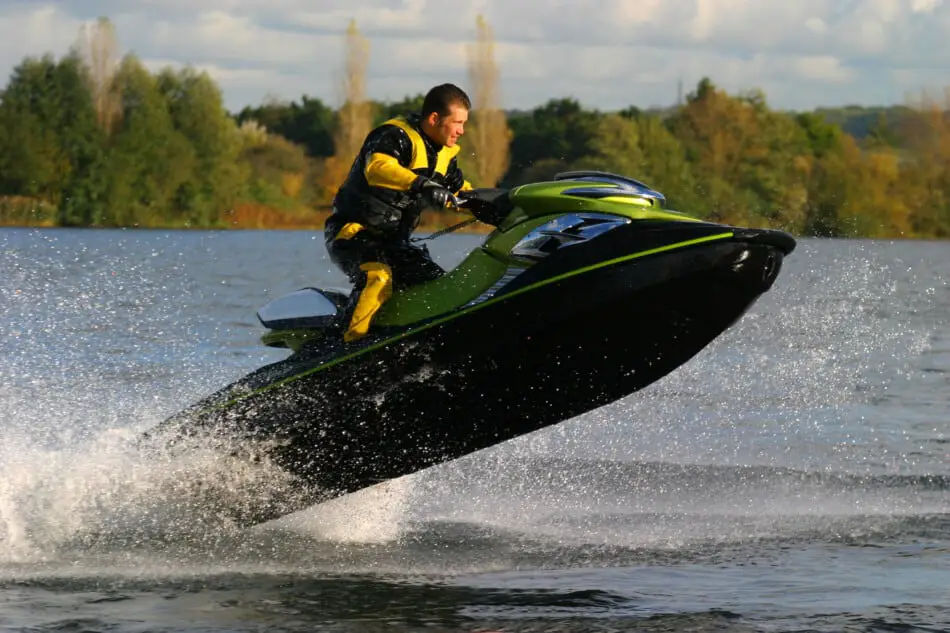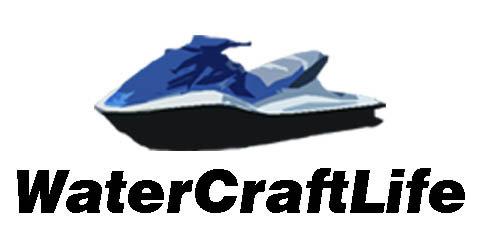
It’s time for another science lesson! Last week, we talked about the chemistry of jet ski engine corrosion. This week, we’re going to discuss the physics of jet ski thrust.
Thrust is one of several components that affect jet ski speed. It’s also what gives the jet ski it’s “get up and go” feeling when you first take off. Some people love the feeling of a really strong thrust, while others couldn’t care less. But if you’re reading this article, you might be wondering, “How much thrust can a jet ski actually produce?”
The amount of thrust a jet ski produces varies based on the speed and size of the jet ski’s jet propulsion system. Average jet skis produce about 950lbs of thrust, while high-performance, supercharged models, like Kawasaki’s Ultra 310LX, can produce up to 1890lbs of thrust.
What is Thrust?
Thrust is the propulsive force that propels an object forward in motion. Most often, thrust is a term that is applied to aircraft, like planes and rockets. However, thrust relates to watercraft too.
Thrust is a physics principle based on Newton’s Third Law of Motion, which states that every action has an equal and opposite reaction. In a motorboat, this happens when the engine activates the propellers, and the propellers in turn accelerate the water backward and push the boat in the opposite direction. In a very oversimplified sense, when the boat pushes the water, the water pushes back, creating motion in the opposite direction.
Jet skis, however, do not produce thrust with an outboard engine and propeller system. Instead, they produce thrust via their jet pump system.
How Does a Jet Ski Produce Thrust?
Jet skis produce thrust by sucking in water and shooting it out the back of the jet ski very quickly. This process begins when the jet pump sucks water in through the intake grate on the bottom of the jet ski. The water is then funneled through the impeller, which is basically a propeller fitted inside of a pipe. The impeller moves the water through the pipe very quickly and propels it out the other side. Some of this water is used to cool the engine (in an open-loop cooling system), while the rest of it is forcibly expelled out the back of the jet ski through an exit nozzle, thus propelling the jet ski forward.
On Yamaha WaveRunners, some of this water is diverted out the spout on the back of the jet ski to create the trademark rooster tail of water that WaveRunners are known for. If you’ve ever watched a jet ski race, you may have noticed that racers who ride WaveRunners don’t have the trademark rooster tail. The reason they don’t has to do with thrust. Most professional racers remove the spout so that all of the thrust is directed out the back of the jet ski, thus keeping all thrust focused on forward momentum. If the water is being shot up in the air instead of out the back, less thrust is being generated, and therefore, less speed, which is not good when you’re in a race.
Understanding thrust is one key to understanding how fast your jet ski can travel through the water.
How Much Thrust Does a Jet Ski Produce?
Kawasaki is the only one of the three major PWC brands that report their jet skis’ thrust in their vehicle specs. This is likely because Kawasaki is the speed brand. Racers and jet ski aficionados who crave speed are likely more interested in thrust than casual rec riders or people using their jet skis for fishing/tow sports.
| Kawasaki Model | Amount of Thrust |
| SX-R | 957 lb |
| STX 160 | 957 lb |
| STX-15F | 957 lb |
| Ultra LX | 957 lb |
| Ultra 310X | 1,890 lb |
Kawasaki’s STX 160LX, STX-15F, and Ultra LX, their lower and mid-range models, all have a thrust of 957lbs, while their supercharged Ultra 310X has a whopping 1890lbs of thrust.
Although Kawasaki is the only brand that reports thrust, Kawasaki, Yamaha, and Sea-Doo all make PWCs with similar specs at each of their different classes. So, for example, you can expect the thrust of a Kawasaki Ultra LX to be comparable to a Yamaha VX/LX series model or a Sea-Doo GTI or GTR, because they are all in a similar class.
Rec-Lite models like the Sea-Doo Spark and the Yamaha EX likely produce less thrust than models with more powerful engines. For example, the horsepower of a Spark is only 90-hp, while Sea-Doo’s RXP-X has a horsepower of 300-hp. A 300-hp engine is going to be capable of a much higher thrust than a 90-hp engine.
Supercharged engines like the Kawasaki Ultra 310X and Yamaha GP1800R SVHO will generate the most thrust.
What Else Affects Jet Ski Speed?
It’s important to know that a higher thrust doesn’t have a 1:1 correlation with higher speeds because there are so many other factors that affect the speed of a jet ski. For example, the top speed of a Kawasaki Ultra 310X, which has nearly double the thrust of the Ultra LX, only goes 15mph faster. How can this be?
Well, many things affect a jet ski’s speed. A supercharged engine like that of an Ultra 310X is certainly going to be capable of generating more force than the Ultra LX’s engine, which is part of why it is a faster model. This is also what explains why a Sea-Doo RXP-X will go faster than a Sea-Doo Spark, as I mentioned above.
However, the overall build and frame of the jet ski will also affect speed. In the example above, although the Ultra 310X has a supercharged engine and 1890lbs. of thrust, it also weighs 20% more, is wider, and may have a different pitch impeller than the Ultra LX, so although it is indeed a faster model, it’s only faster by about 15mph.
As another example, the Kawasaki Ultra LX has a 160-hp engine, which is almost double that of the Sea-Doo Spark (90-hp), but it only goes 5mph faster. This makes more sense when you realize that the dry weight of an Ultra LX is 932lbs while a Spark comes in at a scant 410lbs. The Spark’s lighter frame and smaller build allow it to get higher speeds even though its engine generates less power and produces less thrust.
Additionally, several other variables affect speed such as the speed of the water, drag, and the weight being carried by the jet ski. With this in mind, you can see how understanding the overall speed capabilities of your jet ski goes beyond just understanding thrust.
Converting Horsepower to Thrust
After learning about the different horsepower and thrust of several jet ski models, you might be wondering how horsepower and thrust are different. Well, thrust is a measurement of force, which is measured in weight, while horsepower is a measurement of power, which is measured in watts.
If you’re interested, you can convert horsepower to thrust. You might just be curious about the maximum thrust your Yamaha or Sea-Doo is capable of generating. If so, this article from Sciencing.com explains the conversion equation.
However, be careful when doing this calculation, because it’s important to remember that you’re really only calculating hypothetical thrust in a closed system with very few variables. Riding a jet ski in the real world will likely produce different actual measurements. That being said, the equation can give you an idea of the potential thrust capability of one jet ski compared to another.
Conclusion
Jet ski thrust is one of the key components in understanding how fast a jet ski can go. Thrust is the force that propels an object forward in motion. In the case of a jet ski, thrust is the force with which the jet ski can propel water out the back of the propulsion system, thereby controlling some of the jet ski’s speed.
Typically, jet skis with higher horsepower produce more thrust. This is why supercharged models like the Kawasaki Ultra 310X generate more thrust. That being said, thrust is still only one component that affects a jet ski’s speed, along with horsepower, weight, frame design, and the conditions of the water.
If you really love the feel of taking off with power, looking for a jet ski model with a lot of thrust may be just what you’re looking for. However, it’s good to know that even jet skis that don’t produce a lot of thrust can still get up to pretty high speeds if they are lightweight and aerodynamically designed.
